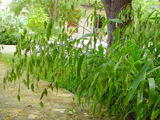Native Plants

Q. Who is Mr. Smarty Plants?
A: There are those who suspect Wildflower Center volunteers are the culpable and capable culprits. Yet, others think staff members play some, albeit small, role. You can torture us with your plant questions, but we will never reveal the Green Guru's secret identity.
Did you know you can access the Native Plant Information Network with your web-enabled smartphone?
Ask Mr. Smarty Plants is a free service provided by the staff and volunteers at the Lady Bird Johnson Wildflower Center.

rate this answer
Friday - June 13, 2008
From: Jackson, TN
Region: Southeast
Topic: Erosion Control
Title: Plants for ditch bank to stop erosion
Answered by: Nan Hampton
QUESTION:
I have a huge ditch on my property. The ditch bank is about 5,000 sq ft. There is a lot of erosion and I am looking to correct the problem. Is there any type of SEED, I am not looking to plant mature plants over that much space, that would be good erosion control and also not grow very high so I will not have to mow it?ANSWER:
Grasses are the very best plants to use for erosion control—especially on slopes—because of their extensive fibrous root systems that are very effective in holding the soil in place. Additionally, they are easy to start by seed. There are lots of choices of grasses for Tennessee. You can look at them all yourself if you go to our Native Plant Database and do a Combination Search, choosing 'Tennessee' from Select states and provinces and 'Grass/Grass-like' from Habit (general appearance). From that list I have chosen a few that should do well and be attractive on your site. Most grasses grow 1.5 to 3 feet tall. I've tried to pick out the shorter ones and tried to pick ones that are attractive when mature as well as when they are green and growing. You will need to choose those from the list that fit your available sunlight and soil moisture. Sedges would also work and are usually shorter than grasses and some are evergreen. The problem with sedges is finding seeds for them rather than small plants. After the grass is established and is controlling the erosion, you can add some wildflowers to grow with them.Bouteloua curtipendula (sideoats grama) 2-3 feet
Carex blanda (eastern woodland sedge) 1-3 feet
Carex cherokeensis (Cherokee sedge) 12-18 inches
Carex pensylvanica (Pennsylvania sedge) 6-12 inches
Chasmanthium latifolium (Inland sea oats) 2-4 feet
Elymus canadensis (Canada wildrye) 2-4 feet
Elymus hystrix var. hystrix (eastern bottlebrush grass) 1-3 feet
Muhlenbergia capillaris (hairawn muhly) 1.5-3 feet
Poa arachnifera (Texas bluegrass) 1-2 feet
Schizachyrium scoparium (little bluestem) 1-3 feet
Read "The Return of Native Grasses to Tennessee" by Andrea Shea from the Tennessee Department of Environment and Conservation for an interesting discussion of native grasses. As stated in this article, you need to be careful about where you get your seeds. You want native seeds that aren't contaminated with invasive species. You can search for seed companies that specialize in native plants in your area in our National Suppliers Directory. On a quick search I found Dropseed Native Plant Nursery in Goshen, Kentucky, Nashville Native LLC in Fairview, Tennessee and Ohio Prairie Nursery in Hiram, Ohio, all of which deal in 100% native plants.
More Erosion Control Questions
Connecticut Plants for a Steep Slope
September 09, 2015 - I am looking for the best plants to retain a steep, dry, fully shaded slope in zone 5, Connecticut. It must be deer resistant. Plant height is not a factor.
view the full question and answer
Removing Texas cedar Juniperus ashei from Blanco River banks
February 26, 2014 - Dear Mr. Smarty Plants,
Should cedar trees be removed from our Blanco River banks to prevent them from sucking too much of our precious water before it makes it into the river system?
If so, what s...
view the full question and answer
Groundcover plants for slope to prevent erosion
June 05, 2008 - Hi,
I have just made a 3/4 acre pond and the south facing slope is too steep to mow.Can you suggest any ground cover plants I could use to look nice and prevent erosion.
view the full question and answer
Need suggestions for plants for a 45 degree slope in Falls Church, VA.
January 23, 2013 - Have a 45 degree hillside 50 feet wide by 60 feet long on north side of 26 story building. Very little sun with the need for soil retention plants. Would like a native plant or plants to cover area...
view the full question and answer
Low-growing plants for steep bank to prevent erosion
March 24, 2010 - We recently bought a house (6 months ago) in Memphis, TN that backs up to a concrete drainage ditch. There is a fairly steep, mostly shaded bank that leads from the flat section of the back yard to th...
view the full question and answer
| Support the Wildflower Center by Donating Online or Becoming a Member today. |

